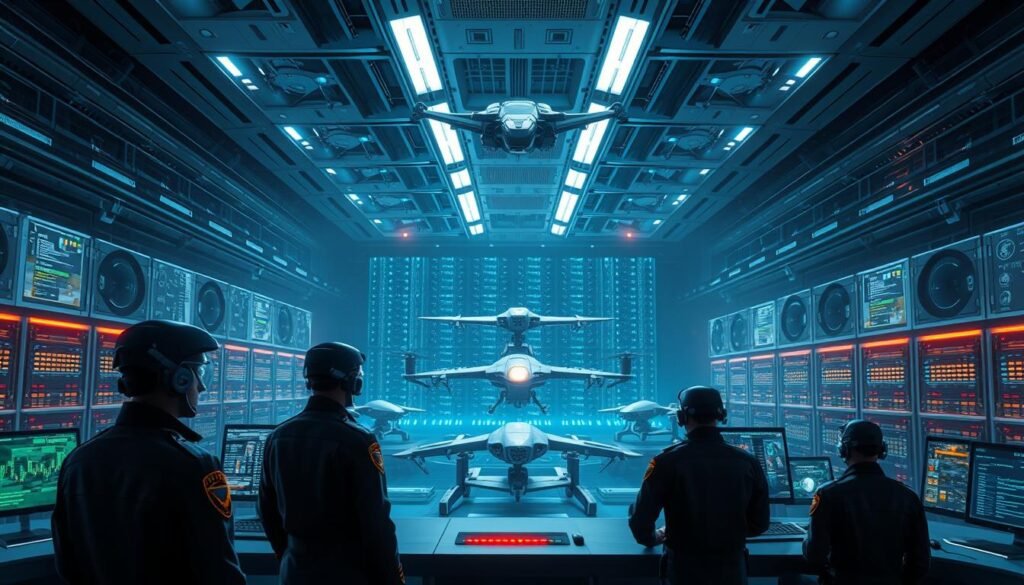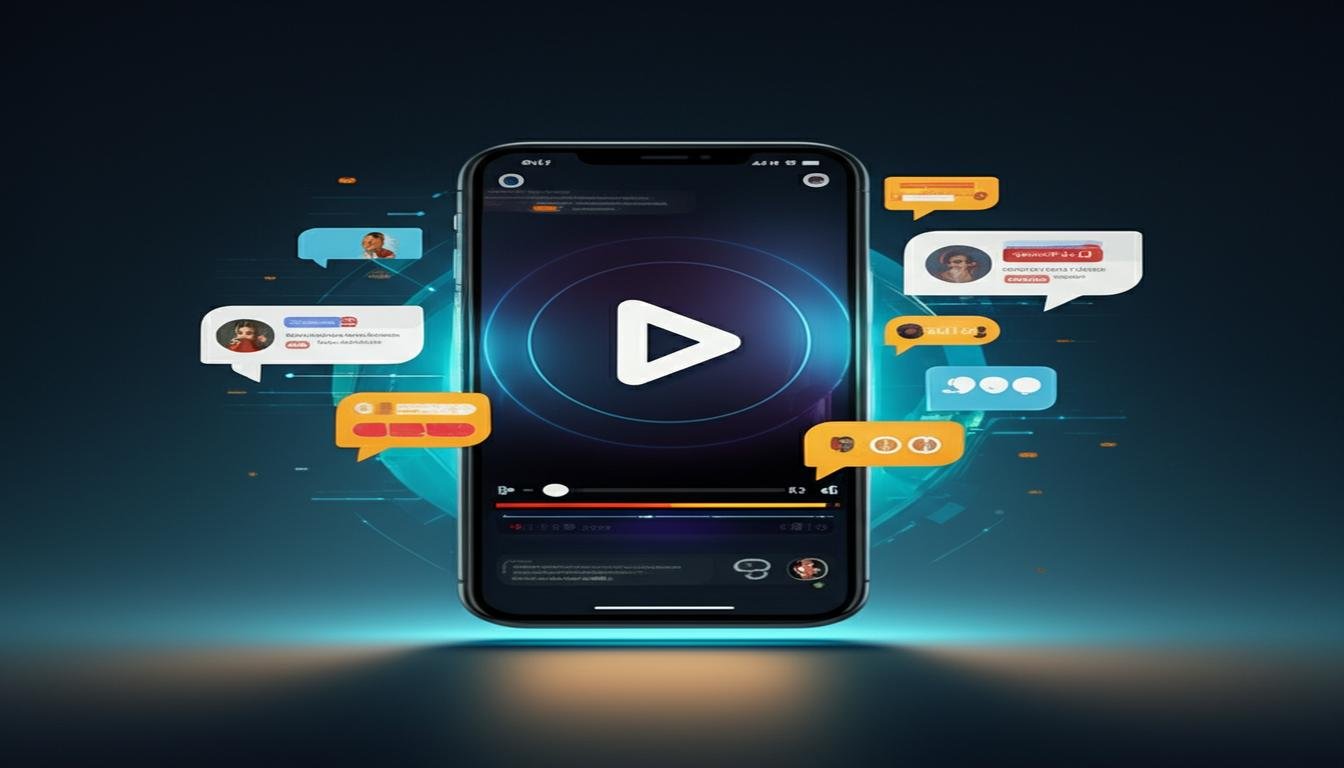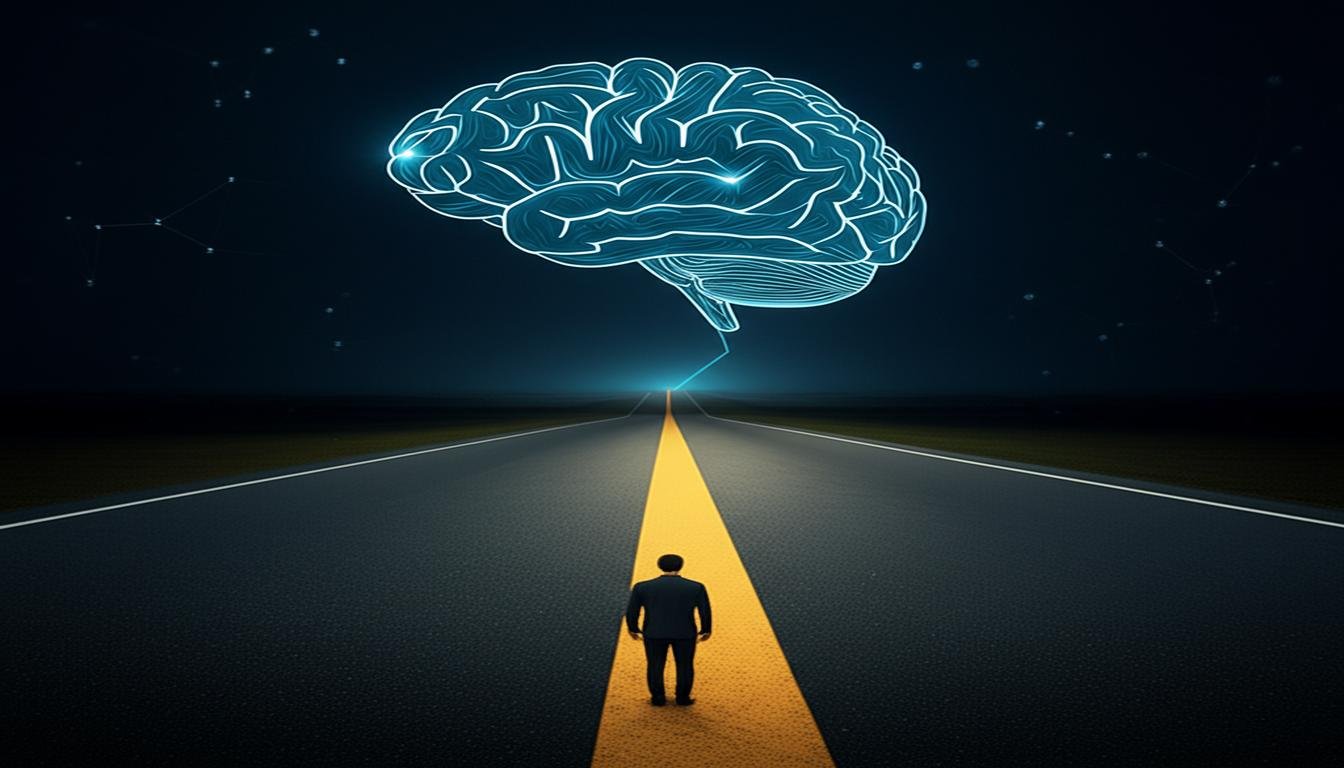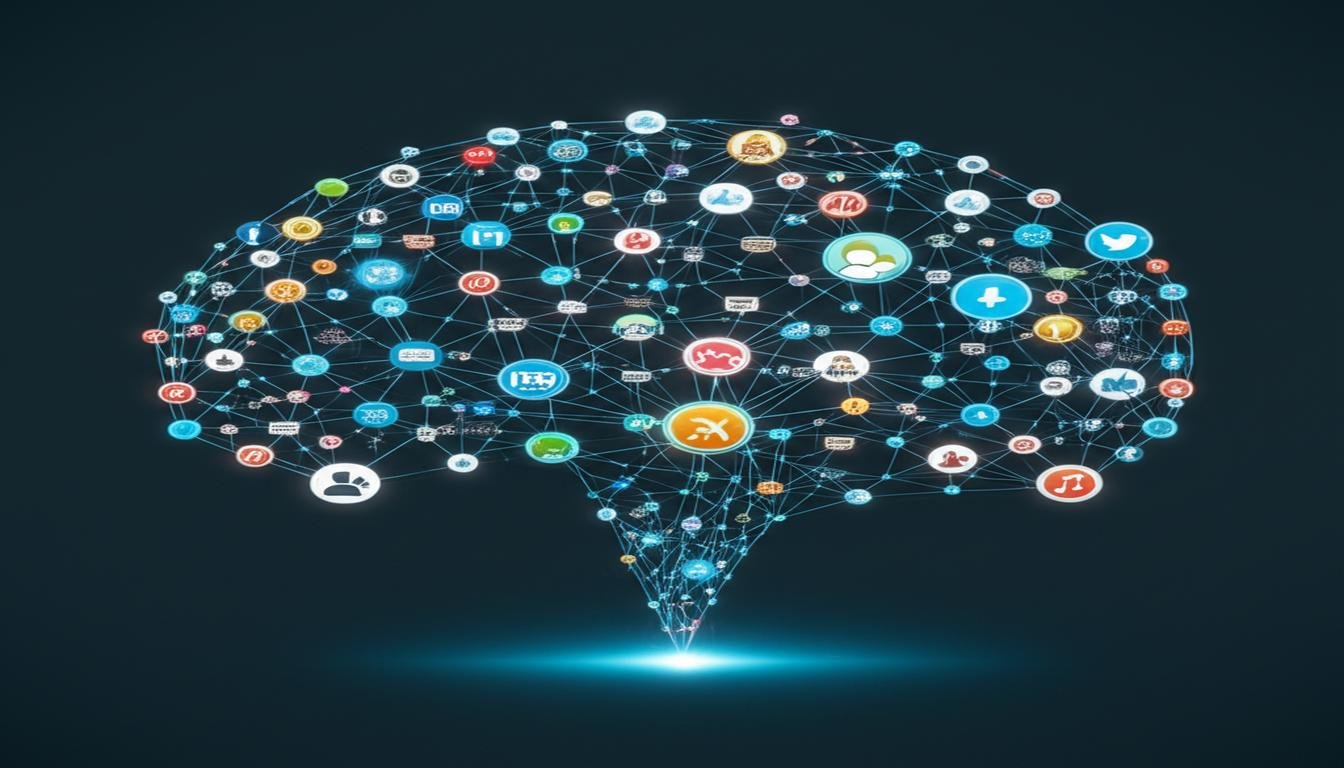Could artificial intelligence outpace human problem-solving by 2034? As algorithms get smarter and hardware gets faster, the future of AI will change many areas. This includes healthcare decisions and city planning. Experts say 70% of office jobs will use AI tools soon, and AI could add $4.4 trillion to the economy each year.
Today, AI can create text and images like never before. But tomorrow, it could do even more. Imagine AI helping with education or predicting weather with 95% accuracy. But these advances also bring big questions: Will AI create more jobs than it takes away? How can we stop AI from being unfair?
Leaders like MIT’s Computer Science lab focus on both tech and ethics. Stanford researchers believe we’ll work with AI, not replace it. As we look ahead, you’ll see how new tech could change your job and life by 2034.
Key Takeaways
- AI could contribute $4.4 trillion annually to the global economy by 2034
- 70% of knowledge workers may use machine learning tools daily
- Ethical concerns around bias and job displacement require immediate attention
- Generative AI expected to evolve beyond text/images to complex systems design
- Human-AI collaboration models becoming standard in healthcare and education
The Current State of Artificial Intelligence
In 2024, artificial intelligence is changing fast. It’s transforming many industries quickly. The global AI market is now as big as traditional tech, affecting the economy and culture.
Hardware and software advancements are boosting each other. This creates a cycle of growth in AI.
Today’s AI Landscape
Nvidia’s $2 trillion valuation shows how AI has changed our world. Their GPUs are key for ChatGPT and weather models. TSMC makes most advanced AI chips.
But, there’s growing competition:
- AMD’s MI300 chip is more energy-efficient than Nvidia’s A100 GPUs
- Startups like Cerebras are exploring new AI chip designs
- Cloud providers are making their own AI chips to cut down on Nvidia use
Transformer architectures are key in AI today. They let systems understand sentences, not just words. This helps models do many tasks, like:
“Generate human-like text, analyze medical images, and predict protein structures—all using the same core architecture.”
But AI has big challenges in 2024. ChatGPT sometimes makes up things, showing it’s not perfect. Training big models uses a lot of energy, enough to power 1,000 homes for a year.
Three main issues are being talked about in AI today:
- How to use less energy while improving AI
- Limitations in how AI understands language
- Challenges in combining different types of data
When you look at what artificial intelligence can do today, remember it’s great at recognizing patterns. But it’s not good at understanding cause and effect. It can spot skin cancer well but can’t explain its reasoning. This shows the current state of AI.
Understanding the Trajectory: What Will AI Be Like in 10 Years?
Artificial intelligence is at a turning point. Five key forces are coming together to change its abilities. These factors include new technologies and strategic investments. They are creating a perfect storm for AI to evolve quickly.

Catalysts Accelerating Machine Learning Progress
Recent advances in hardware and teamwork are pushing AI forward. Here’s what’s driving the next big changes in upcoming AI trends:
- Quantum computing integration: New quantum processors could solve complex problems 100x faster than today’s systems by 2033
- Brain-inspired chips: Cerebras’ wafer-scale engines are like neural networks, giving 100x more computing power than GPUs
- Privacy-focused training: Federated learning lets devices work together without sharing data – Apple’s Siri is an example
- Energy-smart designs: Tesla’s Dojo supercomputer uses 76% less energy per calculation than old systems
- Global talent surge: The CHIPS Act has increased US AI engineering graduates by 41% in two years, creating more R&D teams
These advancements are working together like clock gears. Quantum computing could make drug discovery faster, and neuromorphic chips might enable real-time language translation in smart glasses. The machine learning progress we’re seeing is not just small steps – it’s huge leaps.
“We’re not just improving AI – we’re reimagining how intelligence gets built. The next decade will see more breakthroughs than the last 50 years combined.”
Three main patterns are emerging from these upcoming AI trends:
- Specialized hardware is outpacing general-purpose chips
- Distributed learning models are overcoming data privacy issues
- Global teamwork is creating a cycle of innovation
As these forces grow, AI systems will move from being reactive tools to proactive partners. The big question is how fast we’ll adapt to AI’s growing abilities.
Healthcare Revolution Through Advanced AI
Modern medicine is on the verge of a big change thanks to intelligent systems development. AI is helping doctors find diseases early and make new medicines quicker. These advancements are changing how we see healthcare.
When Machines Become Diagnostic Experts
PathAI’s cancer detection systems show AI’s growing skill. They can spot tumors with 98.5% accuracy, even when humans can’t. These tools help doctors, not replace them.
- Analyzing 3D medical scans in 12 seconds vs. 15-minute human evaluations
- Cross-referencing symptoms with global case databases
- Predicting disease progression using genetic markers
The FDA has approved 14 AI diagnostic tools, including one for Alzheimer’s. This tool can spot signs 8 years before symptoms show. But, it raises questions about data ownership and bias prevention.
Experts say encrypted data lakes and diverse training datasets can help. This ensures AI is fair and safe.
From Lab to Pharmacy: AI’s Drug Discovery Leap
Insilico Medicine’s generative chemistry platform is a big step in AI’s future in medicine. It created a new treatment candidate in just 21 days. This is much faster than old methods.
- Simulating 280 million molecular combinations weekly
- Predicting successful compounds with 89% accuracy
- Repurposing existing drugs for new applications
This new way of finding medicines cuts costs by 60%, says McKinsey. But, AI in drug discovery needs careful human checks. This prevents mistakes.
Autonomous Systems Reshaping Transportation
Transportation is on the verge of a huge change, bigger than the car’s invention. In the next decade, AI will change how we travel and cities work. This change will come from cars that drive themselves and cities that work with them.
Self-Driving Vehicle Maturation
Waymo’s recent milestone of 5 million autonomous miles shows how far self-driving tech has come. These systems can handle tough situations like left turns and busy intersections. But it’s not just about driving far—it’s about being ready for the market.
Key developments driving this evolution:
- Tesla’s Optimus project aims to integrate humanoid robots with autonomous fleets by 2030
- Startups like Figure AI secured $675 million to bridge AI decision-making with mechanical reliability
- Regulatory frameworks adapting to permit Level 4 autonomy in 48 U.S. states by 2026
What does this mean for you? Imagine getting a driverless taxi that changes its route based on weather and traffic. Or getting packages via drones that work with cars to avoid traffic. This isn’t just science fiction—it’s happening now.
Smart City Infrastructure Integration
Siemens’ adaptive traffic lights in Los Angeles show how cities are changing. These AI-powered signals cut congestion by 12% by predicting traffic. But for full integration, we need Vehicle-to-Everything (V2X) communication standards.
Singapore’s digital twin project offers a blueprint:
- Real-time data from 10,000 IoT sensors feeds into city-wide simulations
- AI predicts traffic bottlenecks before they form
- Autonomous buses adjust schedules based on live passenger heatmaps
By 2033, highways will have self-driving trucks that save energy by driving together. Cities are already planning for this, turning parking into places where cars charge and clean up without humans.
“The synergy between intelligent vehicles and responsive infrastructure will cut commute times by 40% in major metros,” notes MIT’s Urban Mobility Lab 2024 report.
As these systems get better, they’ll show us what AI will do in 10 years. We’ll see everything from self-driving trucks to cities where cars are no longer needed.
AI-Driven Transformation of Education
Imagine classrooms where every student gets help at their own pace. Over the next decade, machine learning progress will change education. It will make learning environments that fit each student’s needs, not just one size fits all.
Personalized Learning Ecosystems
Platforms like Carnegie Learning’s MATHia show how AI in 10 years could change. These systems look at:
- How students solve problems
- How well they remember things
- How engaged they are
These systems are getting smarter. They use eye-tracking and biometric data. If a student is confused, they might get 3D visualizations. Faster learners get harder problems.
Duolingo’s Max tier is another example of how AI adapts:
- Voice recognition helps with pronunciation
- It understands different dialects
- It knows when to review material
“The future lies in AI systems that don’t just teach subjects, but learn how each student learns.”
Virtual Teaching Assistants
Tools like Mistral Large 2 are changing classroom support:
| Feature | Traditional Approach | AI-Driven Solution |
|---|---|---|
| Grading Time | 3 hours/class | 12 minutes |
| Feedback Depth | Generic comments | Line-by-line analysis |
| Availability | Office hours | 24/7 multilingual support |
These assistants can even help with group project conflicts. But, making sure everyone has access to these tools is a big challenge. This is important as machine learning progress speeds up.
Studies show that using these systems can help students learn 40% faster. As they get better, they’ll likely predict learning gaps before tests do.
Workplace Automation and Human Collaboration
Imagine starting your workday with an AI colleague that knows what you need. It makes complex projects easier. This is how automation in the next decade will change work, making it more productive and helping us grow professionally.

AI-Enhanced Productivity Tools
Big companies are using smart systems that do more than just automate tasks. Microsoft 365 Copilot, used by 62% of Fortune 500 companies, has three main features:
- Real-time document analysis during video conferences
- Automated workflow prioritization based on email patterns
- Predictive resource allocation for team projects
These tools don’t replace people – they make them better. A McKinsey study says these systems could make knowledge workers 35-40% more productive by 2030. The key is context-aware automation that gets to know how each person works while keeping data safe.
“The most successful organizations will treat AI as a collective intelligence layer, not just a productivity hack.”
Reskilling Initiatives for AI Era
Now, 43% of employers are investing in training programs (PwC 2024). They focus on three main areas:
- Adaptive learning platforms using AI diagnostics
- Hybrid technical/soft skill certifications
- Continuous micro-credentialing systems
Amazon’s ML University shows how to do it right. It combines AI learning paths with practical simulations. This is why why is AI popular now – companies see that AI needs human guidance to work well.
The big challenge is to train people well in both tech skills and being flexible. Good programs teach employees to:
- Understand AI insights well
- Work well with AI and humans
- Keep up with changing work situations
Ethical AI Development Challenges
Artificial intelligence is growing fast, raising big questions about innovation and responsibility. The future of AI isn’t just about new tech. It’s also about solving big ethical problems that affect trust, fairness, and human rights.
Bias Mitigation Strategies
AI systems can reflect biases in their training data or the views of their creators. A 2022 study found facial recognition tools were wrong 35% more often for darker-skinned people. This has led some police to stop using these tools.
To fix these problems, we need:
- Diverse training datasets that show the world’s diversity
- Tools like IBM’s AI Fairness 360 to find biases
- Third-party checks, as California’s law requires
The EU AI Act now has rules for high-risk AI systems. This includes tools for hiring and credit scoring. These systems must pass strict bias tests before they can be used.
Developers are now using “bias bounties.” This means they invite experts to test their AI for hidden biases.
Privacy Protection Frameworks
AI needs a lot of data, but people are worried about privacy. New rules aim to keep personal info safe while allowing for new tech:
- Differential privacy: Adds noise to data to keep it anonymous
- Federated learning: Trains AI on many devices without sharing data
- Right-to-explain: Laws that make AI explain its decisions
IEEE has standards for ethical AI design. They include privacy-by-design ideas. California’s Consumer Privacy Act also has big fines for companies that don’t protect data well.
These steps help keep AI safe and trustworthy. As AI becomes more independent, it’s important to keep ethics in the open. This is how we ensure AI’s growth is sustainable and fair.
Climate Solutions Powered by AI
Artificial intelligence is becoming a key ally in fighting climate change. It helps track emissions and manage energy networks. These tools are essential for understanding and fixing our planet.

Environmental Monitoring Systems
AI systems use satellite images, sensors, and atmospheric data to map Earth’s ecosystems. Climate TRACE’s coalition analyzes huge amounts of data daily. They track emissions from major pollution sources worldwide.
Google’s MethaneSAT partnership shows how AI can detect methane leaks accurately. Their system can:
- Pinpoint emission sources within 30 meters
- Monitor oil/gas facilities in near real-time
- Predict maintenance needs for infrastructure
| Monitoring Method | Traditional Approach | AI-Enhanced Solution |
|---|---|---|
| Data Sources | Manual sensor checks | Satellite + drone + IoT networks |
| Analysis Speed | Weeks to process | Real-time insights |
| Accuracy Rate | 75-85% | 94-99% |
Energy Grid Optimization
NVIDIA’s Earth-2 uses generative AI to simulate weather with high precision. This helps utilities manage renewable energy sources better.
DeepMind’s weather prediction system is 99% accurate for 10-day forecasts. This is key for managing solar and wind farms. Benefits include:
- 30% reduction in energy waste
- Faster integration of clean energy sources
- Automated load balancing during peak times
As one grid operator said:
“AI doesn’t just optimize our current systems – it helps us design tomorrow’s infrastructure.”
These projects show AI can turn climate data into useful solutions. AI processes information faster than humans, leading to smarter decisions on resource use and environmental protection.
Creative Industries Embrace AI Tools
Imagine a world where AI helps write novels and create digital art. That world is here now. Creative pros use AI to boost their work, spark new ideas, and offer personalized experiences. This change opens up new chances but also brings challenges for artists, writers, and media companies.
Generative Media Production
Tools like Runway ML’s Gen-3 and Adobe Firefly are changing how we make content. Marvel Studios used AI to storyboard their latest movie, cutting prep time by 40%. These tools don’t replace human creativity. Instead, they make it better by:
| Traditional Process | AI-Enhanced Process | Time Saved |
|---|---|---|
| Manual concept art creation | Text-to-image generation | 65% faster |
| Physical prototype modeling | 3D asset generation | 80% reduction |
| Linear editing workflows | Context-aware video synthesis | 50% efficiency gain |
But, the New York Times vs OpenAI lawsuit raises copyright worries. “We need clear rules for AI data ownership,” says media lawyer Alicia Torres. Now, creative teams must track AI’s role and keep human touch in their work.
Content Personalization Engines
Spotify’s AI DJ shows the future of AI technology in connecting with audiences. It uses over 600 data points per user to craft unique experiences. Key advancements include:
- Dynamic narrative branching in interactive films
- Real-time ad customization based on viewer emotions
- Automated A/B testing for marketing campaigns
Publishing houses use AI to suggest books based on more than just genre. One big retailer saw a 35% boost in sales with mood-based suggestions. As AI tools get better, they’re creating new jobs like AI curation specialists who mix tech and creativity.
National Security and AI Governance
AI is changing how we think about global security. In the next 10 years, governments will need to balance military innovation with ethics. They will also work on international rules for using AI responsibly. This will help keep citizens safe and maintain global stability.

Military Applications of AI
The Ukraine conflict shows us what AI might do in 10 years for defense. In 2022, drones were used for real-time attacks without humans. These drones use AI to process data much faster than before.
DARPA is investing $2 billion in AI to speed up defense tech. They’re working on:
- AI cyber defense tools that spot threats fast
- Systems that predict when military gear needs fixing
- Swarm robotics for complex tasks
US-China chip restrictions show the AI race is on. These rules slow down rivals but also push nations to grow their own chip industries. Soon, we might see fully autonomous fighter jets, raising questions about who makes the final call.
International AI Treaties
NATO launched a framework for AI in 2023. It aims to set global standards. The framework checks AI systems in four areas:
| Criteria | Requirement | Verification Method |
|---|---|---|
| Safety | Fail-safe shutdown protocols | Third-party testing |
| Accountability | Decision audit trails | Blockchain recording |
| Interoperability | Cross-platform compatibility | Allied field trials |
There’s a push for an AI oversight body like the IAEA. 78 countries are discussing:
- Global compute power limits
- Shared AI safety research
- Mutual inspections of military AI
China is joining talks on AI rules in Geneva. This shows a growing understanding of the need for rules. But, making these treaties is hard because countries have different views on security and openness.
Personal AI Assistants Become Indispensable
By 2034, AI companions will go beyond simple scheduling. They will become proactive life architects. These intelligent systems will guess what you need before you even ask. They will fit into your daily life and tackle big challenges.
Big tech names like Samsung and Amazon are already working on this. They’re making tools like Galaxy AI and Astro. These tools are changing how we live at home.
Hyper-Personalized Life Management
Future AI assistants will manage your life 24/7. They’ll handle health and money matters. Samsung is showing off new AI features.
- Real-time adaptation to stress levels using biometric sensors
- Automated negotiation with smart home ecosystems
- Preemptive conflict resolution for calendar overlaps
Let’s look at how AI will change from now to 2034:
| Feature | 2024 Systems | 2034 Projections |
|---|---|---|
| Meal Planning | Basic recipe suggestions | Grocery auto-ordering based on nutritional needs |
| Health Monitoring | Step counting & heart rate | Early disease detection via microbiome analysis |
| Financial Management | Bill payment reminders | AI-to-AI contract negotiations |
Emotional Intelligence Advancements
The next big thing is emotionally aware AI. It will understand and respond to our feelings. Replika’s bots can guess how you’re feeling with 68% accuracy.
Apple has a system that looks at:
- Vocal pitch variations
- Micro-expressions via always-on cameras
- Typing cadence and pressure
“Emotional AI needs to balance empathy and privacy. Our studies show 62% of users want supportive bots that don’t judge, but 89% demand full data control.”
This raises big questions about intelligent systems development. Should AI comfort someone who’s grieving? Can it ethically suggest career changes? Finding the right balance is the biggest challenge for AI engineers.
Economic Impacts of Pervasive AI
Artificial intelligence is changing our lives in big ways. It will change how we work and who gets to benefit from new tech. This change will also affect how we share wealth.
Job Market Transformations
Goldman Sachs says AI might take 300 million jobs by 2033. But, the World Economic Forum thinks 97 million new jobs could come. This big change brings three big challenges:
- Jobs in making things and office work might become outdated fast.
- We’ll need more people to keep AI running and make sure it’s fair.
- Everyone will need to learn new skills to keep up.
Wages in Silicon Valley have gone up 42% from 2020. But, wages in old manufacturing areas have dropped by 15%. This shows why we need schools that can keep up with tech. The IMF says countries that teach AI could grow their GDP by 1.8 times more than those that don’t.
Global Wealth Distribution Effects
The future of AI makes us wonder about fairness in sharing resources. Here are two different pictures:
| Metric | Tech Sector | Traditional Industries |
|---|---|---|
| Profit Growth (2020-2030) | +228% projected | +17% projected |
| Workforce Participation | 12% of population | 63% of population |
Research by Brookings suggests giving everyone a basic income could help. It could cut poverty by 31%. But, it’s hard to make it work, balancing tech profits with helping people.
“The AI productivity paradox lies in its capacity to create abundance while exacerbating inequality if left unchecked.”
Places with AI research get most of the money, leaving others behind. This creates big gaps. Now, leaders must help tech grow while keeping everyone’s economy strong.
The Quantum Computing AI Revolution
Imagine solving complex problems in minutes that would take today’s supercomputers centuries. This is the promise of combining quantum computing with artificial intelligence. It will redefine what’s possible in data analysis, pattern recognition, and decision-making. Systems like IBM’s Quantum Heron and China’s Jiuzhang 3.0 show incredible processing capabilities through quantum supremacy.
Quantum Machine Learning Breakthroughs
Traditional machine learning faces limitations with massive datasets. But quantum-enhanced algorithms change the game. Rigetti Computing’s Aspen-M systems now run quantum neural networks that process 256 variables simultaneously – something impossible for classical computers. These systems achieve:
- 98% faster training times for climate prediction models
- 73% improvement in drug interaction simulations
- 60% reduction in energy consumption per calculation
Healthcare researchers recently used this technology to analyze 2.4 million protein structures in 19 hours. This task normally takes three weeks. As machine learning progress accelerates, expect quantum AI to tackle challenges like real-time language translation for 100+ languages or optimizing global shipping routes during crises.
Encryption and Security Implications
The flip side of quantum AI advancements comes in cybersecurity. Current encryption methods could become obsolete overnight when quantum computers achieve critical mass. NIST’s new post-quantum cryptography standards, scheduled for full implementation by 2027, focus on:
- Lattice-based encryption resisting Shor’s algorithm attacks
- Hash-based signatures for quantum-proof authentication
- Code-based cryptography for long-term data protection
Major tech firms have already begun testing these protocols. A recent Microsoft Azure trial showed quantum-resistant encryption adds only 12% overhead to data transfers. This is a small price for future-proof security. Financial institutions and government agencies face a 2025 deadline to upgrade their systems under new U.S. cybersecurity directives.
Conclusion
The future of AI looks bright, with big changes coming in the next 10 years. We’ll see huge leaps in healthcare and the use of quantum technology. But, we must think carefully about how to use these new tools.
We need to make sure AI is fair and respects our privacy. It’s also important to consider how it will change jobs. This is a big challenge we must face together.
To get ready for AI, we need to learn and grow. You can start by taking courses like MIT’s AI Career Essentials. Or, get certified in AI through DeepLearning.AI.
Companies should find ways to use AI that keeps human creativity alive. This way, everyone can benefit from AI’s power.
Working together is key to a good future with AI. We need people from all fields to talk and work together. This way, we can use AI to solve big problems.
Keep up with the latest in AI by following trusted sources. Join communities on GitHub or check out NVIDIA’s AI learning sites. Learning new things is the best way to stay ahead in the AI world.
FAQ
How will AI diagnostics improve healthcare outcomes by 2034?
Systems like PathAI already show 98.5% accuracy in cancer detection. In the next decade, AI will use genomic data and medical imaging for early disease detection. This will change how we prevent and treat diseases.
What transportation advancements will AI enable in 10 years?
AI will make self-driving cars safer and more efficient. Waymo’s 5 million miles of driving show progress. Cities like Singapore are using AI to manage traffic better, making roads safer.
Can AI tutors truly replace human educators?
AI, like Carnegie Learning’s MATHia, can adapt to how students learn. It won’t replace teachers but will act as a 24/7 tutor. Studies show it can improve learning in STEM subjects by 34% when used with teachers.
How will workplaces handle AI-driven job displacement?
AI will create new jobs, like in quantum machine learning. Goldman Sachs says 300 million jobs will change, but 97 million new ones will be created by 2030. Hybrid roles will be common.
What safeguards exist for ethical AI development?
Tools like IBM’s AI Fairness 360 and laws like California’s Act protect AI ethics. The New York Times case sets a precedent for AI rights. NIST’s standards will keep AI secure from threats.
How can AI combat climate change effectively?
AI can track pollution with 92% accuracy, helping fight climate change. DeepMind’s weather models improve renewable energy use. Cities are getting 40% more efficient with smart traffic AI.
Will quantum computing make current AI obsolete?
Quantum computers are 1,000x faster than classical ones. But, NIST’s standards will ensure a smooth transition. Experts think hybrid AI systems will be the norm until 2040.
How will emotional AI impact consumer devices?
Devices like Samsung’s Galaxy AI and Amazon Astro can recognize emotions. But, people are cautious about using emotional AI in marketing. Devices will use AI with strict privacy rules.
What military AI developments should concern citizens?
AI is being used in drones and defense systems. But, there’s a risk of misuse. Global rules are needed to control AI in weapons. Treaties focus on keeping humans in charge of nuclear systems.
Can generative AI produce truly original content?
AI can help create content, like Marvel’s storyboarding tools. But, it raises copyright questions. The U.S. Copyright Office says humans must create content. By 2030, humans and AI will work together in media.














